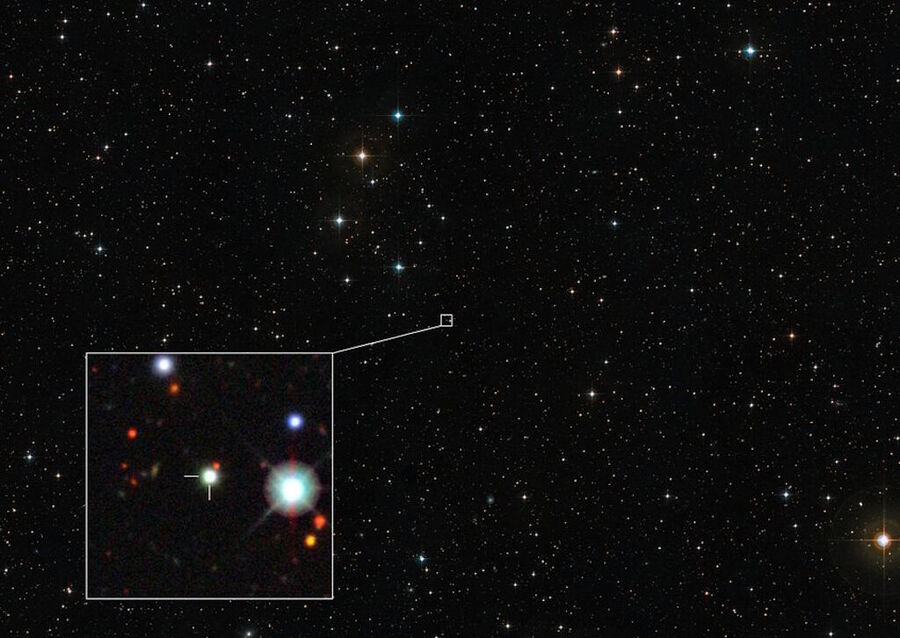
A newly discovered quasar is a real record-breaker. Not only is it the brightest quasar ever seen, but it's also the brightest astronomical object in general ever seen. It's also powered by the hungriest and fastest-growing black hole ever seen — one that consumes the equivalent of over one sun's mass a day.
The quasar, J0529-4351, is located so far from Earth that its light has taken 12 billion years to reach us, meaning it is seen as it was when the 13.8 billion-year-old universe was just under 2 billion years old.
The supermassive black hole at the heart of the quasar is estimated to be between 17 billion and 19 billion times the mass of the sun; each year, it eats, or "accretes" the gas and dust equivalent to 370 solar masses. This makes J0529-4351 so luminous that if it were placed next to the sun, it would be 500 trillion times brighter than our brilliant star.
Record-breaking quaser's growth is equivalent to 'one Sun per day'
"We have discovered the fastest-growing black hole known to date. It has a mass of 17 billion suns and eats just over a sun per day," team leader and Australian National University astronomer Christian Wolf said in a statement. "This makes it the most luminous object in the known universe."
J0529-4351 was spotted in data over 4 decades ago but was so bright that astronomers failed to identify it as a quasar.
How a quasar fooled astronomers for 44 years
Quasars are regions at the hearts of galaxies that host supermassive black holes surrounded by the gas and dust these voids feed on. The violent conditions in disks of matter around such active black holes, called accretion disks and generated by the immense gravity of the objects, heat the gas and dust and cause it to glow brightly.
Additionally, any matter in these disks that doesn't get accreted by a black hole is channeled to the poles of the cosmic titan, where it is blasted out as a jet of particles at near the speed of light, also generating powerful light. As a result, quasars in these Active Galactic Nuclei (AGN) regions can shine brighter than the combined light of billions of stars in the galaxies around them.
But even for these exceptionally bright events, J0529-4351 stands out.
The light of J0529-4351 comes from the massive accretion disk that feeds the supermassive black hole, which the team estimates has a diameter of around 7 light-years. That means crossing this accretion disk would be equivalent to traveling between Earth and the sun around 45,000 times.

J0529-4351 was initially spotted in the Schmidt Southern Sky Survey, which dates back to 1980, but it took decades to confirm it was a quasar to begin with. Large astronomical surveys deliver so much data that astronomers need machine-learning models to analyze them and sort quasars from other celestial objects.
These models are also trained using currently discovered objects, which means they can miss candidates with exceptional properties like J0529-4351. Indeed, this quasar is so bright that models passed it over believing it to be a star located relatively close to Earth.
This misclassification was spotted in 2023, when astronomers realized J0529-4351 is, in fact, a quasar after having a look at the object's region using the 2.3-meter telescope at the Siding Spring Observatory in Australia.
The new discovery that this is actually the brightest quasar ever was made when the X-shooter spectrograph instrument on the Very Large Telescope (VLT) in the Atacama Desert region of Northern Chile followed up on J0529-4351.
Astronomers aren't done with J0529-4351 just yet.
The team thinks the supermassive black hole at the heart of this quasar is feeding near the Eddington limit, or the point at which the radiation it puts out should push away gas and dust, cutting off this black hole's cosmic larder.
Confirming this will require a further detailed investigation. Fortunately, however, the greedy supermassive black hole is the perfect target for an upgraded GRAVITY + instrument at the VLT, which will improve the high-contrast precision on bright objects.
J0529-4351 will also be investigated by the upcoming Extremely Large Telescope (ELT), currently under construction in the Atacama Desert.
However, it is the thrill of finding something new and exciting that drives the leader of the team behind this record-breaking discovery.
"Personally, I simply like the chase. For a few minutes a day, I get to feel like a child again, playing treasure hunt, and now I bring everything to the table that I have learned since," Wolf concluded.
The team's research was published on Monday (Feb. 19) in the journal Nature Astronomy.
Robert Lea is a science journalist in the U.K. whose articles have been published in Physics World, New Scientist, Astronomy Magazine, All About Space, Newsweek and ZME Science. He also writes about science communication for Elsevier and the European Journal of Physics. Rob holds a bachelor of science degree in physics and astronomy from the U.K.'s Open University. Follow him on Twitter @sciencef1rst.



science.com: just believe us, trust the science
me : yeah ok... [Link]